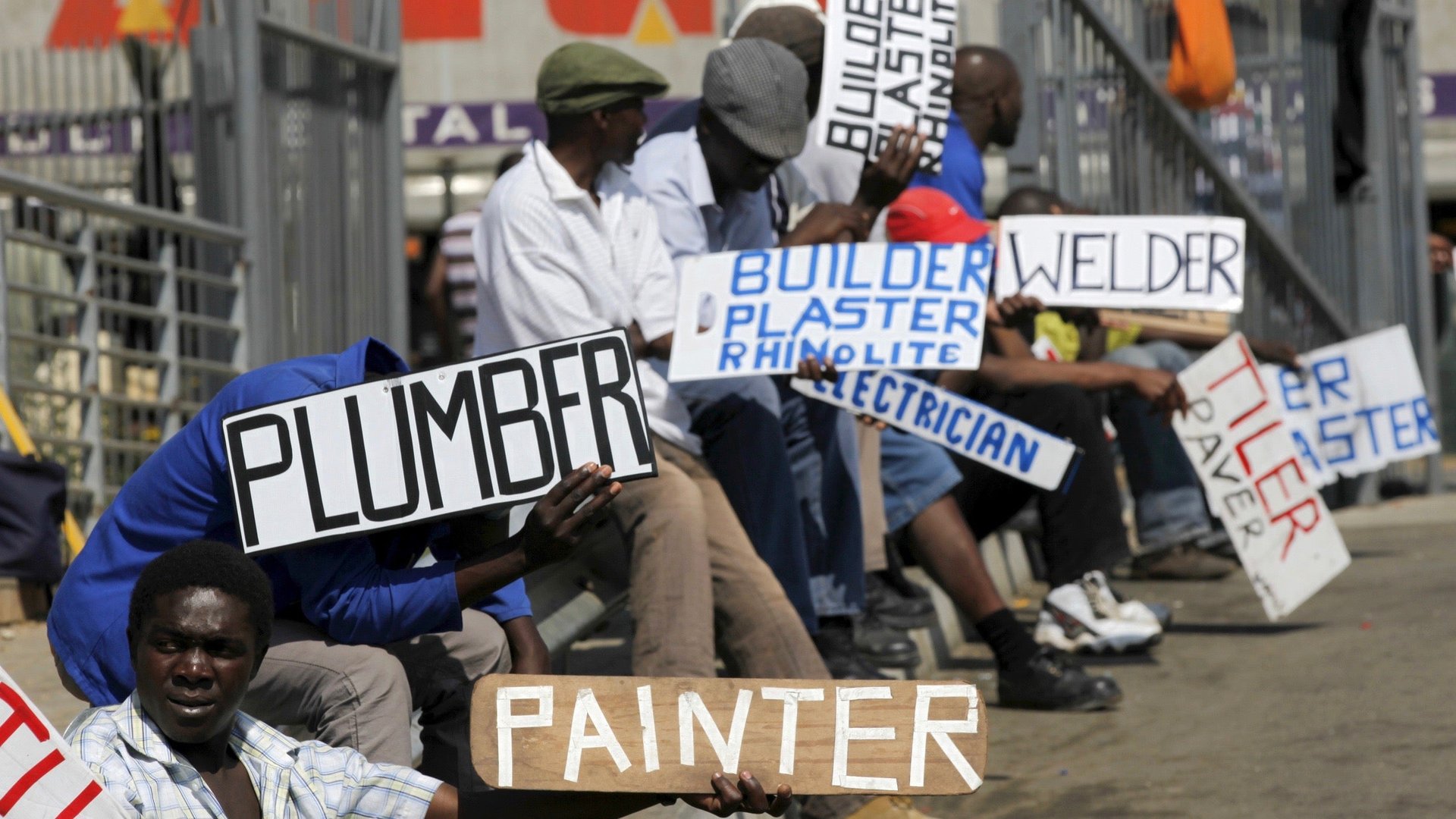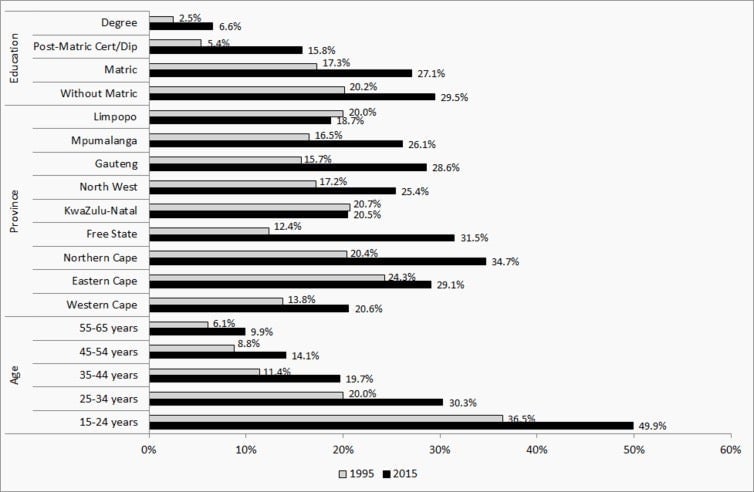Finishing secondary school and moving to a city isn’t enough to find a job in South Africa
Employment has increased in South Africa over the past 20 years, but it has not been rapid enough to absorb all new job seekers into the labor market. Unemployment has therefore also increased and remains very high.


Employment has increased in South Africa over the past 20 years, but it has not been rapid enough to absorb all new job seekers into the labor market. Unemployment has therefore also increased and remains very high.
The most recent figures show a jobless rate of 25.4%, up from 17.6% in 1995. This means that one out of four South Africans in the labor force failed to find work in 2015. This is a far cry from the government’s goal of reducing unemployment to below 15% by 2014.
A study, reported in a working paper on the South African labour market to be published shortly, shows two problematic trends that contribute to the unemployment crisis.
The first is that having a matric – the country’s highest secondary school qualification – no longer leads to better labor-market opportunities. In 2015 the unemployment rate of matriculants was very high, at 27.1%. And having a matric only offered a marginal advantage. The unemployment rate for those without a matric was just two percentage points higher.
Ten years ago matriculants were, in fact, better off. The unemployment rate of this cohort stood at 17.2% in 1996. And the difference between those with matric who got a job was 6.6 percentage points higher than those without matric.
What this suggests is that those without a post-matric qualification face gloomy prospects in finding work. Their education and skills levels are not high enough to meet the current skills requirement of employers.
Second, there is no longer a guarantee that it will be easier to find a job in South Africa’s two most developed provinces – the Western Cape and Gauteng. The unemployment rates in these provinces was actually higher in 2015 when compared with most of the country’s other, poorer provinces.
Structural changes in the economy
Structural change of the South African economy has been taking place continuously since the advent of democracy in 1994. The demand for relatively less educated, unskilled labor, for example in primary industries such as agriculture and mining, has continued to decline. This explains why there is a greater demand for older, highly educated workers. They have longer years of work experience and are more skilled to match the requirements of employers, particularly in economically advanced provinces like Gauteng and the Western Cape.
These two provinces have always accounted for nearly half of the country’s gross domestic product: Gauteng for about a third and the Western Cape for 14%. And the two provinces account for a high share of gross value added in highly skilled industries like transport, finance and personal services.
In 2015 more than 60% of highly skilled occupations like professionals, legislators and managers were located in Gauteng and the Western Cape. Gauteng accounted for about 44% and the Western Cape for just over 17%. This implies that these provinces have the greatest demand for highly skilled labor.
The rapid increase of unemployment rates between 1995 and 2015 in the two provinces may therefore not be surprising. It is possible that a lot of job seekers without the required level of skills and education migrated to Gauteng and the Western Cape. They came with high hopes of finding a job, but failed to do so. They nevertheless decided to stay and carry on seeking work.
Another worrying trend is that a high proportion of young job seekers are seriously struggling to find their first job. The high unemployment rate for job seekers under the age of 35 is extremely high. A staggering 58.4% of 18- to 29-year-olds have never worked before.

Other findings included:
- the number of formal sector employees working for firms with fewer than ten employees has been stagnating, at about 3 million. This is despite government’s continuous efforts to promote the development of small-, micro- and medium-sized enterprises. Their development is extremely important as they are relatively more labor-intensive;
- the proportion of formal sector employees being hired on a permanent basis has been decreasing rapidly, from 85% in 1999 to 68% in 2015; and
- younger job seekers are more likely to search for work through advertisements or the internet. Older job seekers are still more likely to look for work by relying on relatives and friends.
Finding solutions
Despite government’s efforts, the labor market still suffers from high unemployment. So what more can be done?
Reform in South Africa’s education system may provide the only sustainable solution. It is important to reduce the number of poorly educated people by improving school resources and quality of education. Increasing student enrollment and pass rates in subjects like mathematics and science, and reducing high school drop-out rates is also important.
The Employment Tax Incentive, also known as the youth wage subsidy, could help boost the demand for young workers. The subsidy was implemented only two years ago so more time is needed before its long-term effect can be evaluated.
For older unemployed South Africans who have some past work experience, programs such as the Expanded Public Works Programme are essential to upgrade their skills.
Programs such as the Expanded Public Works Programme are very important to upgrading the skills of unskilled workers. This is because, despite an increase in demand for highly skilled workers they still accounted for only about 15% of all those employed in 2015. In fact, across all provinces, slightly more than half of the employed were involved in semi-skilled occupations such as technicians, clerks and machine operators. This proportion was particularly higher in Gauteng (59%) and KwaZulu-Natal (58%). Improving their skills through the Public Works Programme would put them in a better position to fill the semi-skilled positions.
It is also crucial for government to address wage rigidity. In some sectors wage increases are too rapid when compared with labor productivity increases. This results in employers either retrenching expensive labor, or retaining workers on a non-permanent basis.
In addition, a transport subsidy for the unemployed should be given serious consideration, as poor households spend a much higher proportion of their income on transport.
This is an extract from a working paper titled “South African labor force 1995-2015”, which the writers have co-authored. They received assistance on the working paper from Lyle Festus, a former Economics Honours student at the university of the Western Cape.
Derek Yu, Senior Lecturer, Economics, University of the Western Cape; Atoko Kasongo, Lecturer, Economics, University of the Western Cape, and Mariana Moses, Lecturer, Economics, University of the Western Cape.
This article was originally published on The Conversation. Read the original article.